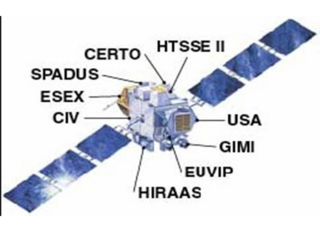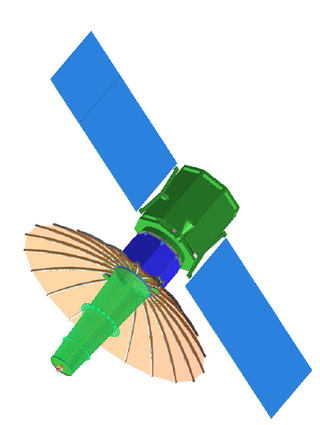
Delta IV was a group of five expendable launch systems in the Delta rocket family. It flew 45 missions from 2002 to 2024. Originally designed by Boeing's Defense, Space and Security division for the Evolved Expendable Launch Vehicle (EELV) program, the Delta IV became a United Launch Alliance (ULA) product in 2006. The Delta IV was primarily a launch vehicle for United States Air Force (USAF) military payloads, but was also used to launch a number of United States government non-military payloads and a single commercial satellite.

Pegasus is an air-launched multistage rocket developed by Orbital Sciences Corporation (OSC) and later built and launched by Northrop Grumman. Pegasus is the world's first privately developed orbital launch vehicle. Capable of carrying small payloads of up to 443 kg (977 lb) into low Earth orbit, Pegasus first flew in 1990 and remained active as of 2021. The vehicle consists of three solid propellant stages and an optional monopropellant fourth stage. Pegasus is released from its carrier aircraft at approximately 12,000 m (39,000 ft) using a first stage wing and a tail to provide lift and altitude control while in the atmosphere. The first stage does not have a thrust vector control (TVC) system.
Orbital Sciences Corporation was an American company specializing in the design, manufacture, and launch of small- and medium- class space and launch vehicle systems for commercial, military and other government customers. In 2014, Orbital merged with Alliant Techsystems to create a new company called Orbital ATK, Inc., which in turn was purchased by Northrop Grumman in 2018. The remnants of the former Orbital Sciences Corporation became a subsidiary of Northrop Grumman, known as Northrop Grumman Space Systems.

The Boeing X-37, also known as the Orbital Test Vehicle (OTV), is a reusable robotic spacecraft. It is boosted into space by a launch vehicle, then re-enters Earth's atmosphere and lands as a spaceplane. The X-37 is operated by the Department of the Air Force Rapid Capabilities Office, in collaboration with United States Space Force, for orbital spaceflight missions intended to demonstrate reusable space technologies. It is a 120-percent-scaled derivative of the earlier Boeing X-40. The X-37 began as a NASA project in 1999, before being transferred to the United States Department of Defense in 2004. Until 2019, the program was managed by Air Force Space Command.

Milstar is a constellation of military communications satellites in geosynchronous orbit, which are operated by the United States Space Force, and provide secure and jam-resistant worldwide communications to meet the requirements of the Armed Forces of the United States. Six spacecraft were launched between 1994 and 2003, of which only five were operational after launch; the third launch failed, both damaging the satellite and leaving it in an unusable orbit.

Atlas V is an expendable launch system and the fifth major version in the Atlas launch vehicle family. It was originally designed by Lockheed Martin, now being operated by United Launch Alliance (ULA), a joint venture between Lockheed Martin and Boeing. It is used for DoD, NASA, and Commercial payloads. It is America's longest-serving active rocket. After 87 launches, in August 2021 ULA announced that Atlas V would be retired, and all 29 remaining launches had been sold. As of June 2024, 16 launches remain. Other future ULA launches will use the new Vulcan Centaur rocket. Production ceased in 2024.

The Minotaur is a family of United States solid fuel launch vehicles derived from converted Minuteman and Peacekeeper intercontinental ballistic missiles (ICBM). They are built by Northrop Grumman via contract with the Space Force's Space Systems Command as part of the Space Force's Rocket Systems Launch Program (RSLP) which converts retired Intercontinental Ballistic Missiles into space and test launch systems for U.S. government agencies.

United Launch Alliance, LLC (ULA) is an American launch service provider formed in December 2006 as a joint venture between Lockheed Martin Space and Boeing Defense, Space & Security. The company designs, assembles, sells and launches rockets, but the company subcontracts out the production of rocket engines and solid rocket boosters.

Genesis II is the second experimental space habitat designed and built by the private American firm Bigelow Aerospace, launched in 2007. As the second module sent into orbit by the company, this spacecraft built on the data and experience gleaned from its previously orbited sister-ship Genesis I. Like its sister-ship and other modules being designed by Bigelow Aerospace, this spacecraft was based on the NASA TransHab design, which provided increased interior volume and reduced launch diameter along with potentially reduced mass compared to traditional rigid structures.
The Space Test Program (STP) is the primary provider of spaceflight for the United States Department of Defense (DoD) space science and technology community. STP is managed by a group within the Advanced Systems and Development Directorate, a directorate of the Space and Missile Systems Center of the United States Space Force. STP provides spaceflight via the International Space Station (ISS), piggybacks, secondary payloads and dedicated launch services.

The Wideband Global SATCOM system (WGS) is a high capacity United States Space Force satellite communications system planned for use in partnership by the United States Department of Defense (DoD), Canadian Department of National Defence (DND) and the Australian Department of Defence. The system is composed of the Space Segment satellites, the Terminal Segment users and the Control Segment operators.

TacSat-3 is the second in a series of U.S. military experimental technology and communication satellites. It was assembled in an Air Force Research Laboratory (AFRL) Space Vehicles Directorate facility at Kirtland Air Force Base, New Mexico. The TacSat satellites are all designed to demonstrate the ability to provide real-time data collected from space to combatant commanders in the field.

The Advanced Research and Global Observation Satellite (ARGOS) was launched on 23 February 1999 carrying nine payloads for research and development missions by nine separate researchers. The mission terminated on 31 July 2003.
The Operationally Responsive Space Office is a joint initiative of the United States Department of Defense (DoD). The "stand up" of the office took place 21 May 2007 at Kirtland Air Force Base. The first director of the ORS Office was Col. Kevin McLaughlin, who was also the commander of the Space Development and Test Wing located at Kirtland. The ORS Office focuses on providing quick-response tactical space-based capabilities; utilizing smaller satellites, such as the Tactical Satellite Program and smaller launch vehicles.

Minotaur IV, also known as Peacekeeper SLV and OSP-2 PK is an active expendable launch system derived from the LGM-118 Peacekeeper ICBM. It is operated by Northrop Grumman Space Systems, and made its maiden flight on 22 April 2010, carrying the HTV-2a Hypersonic Test Vehicle. The first orbital launch occurred on 26 September 2010 with the SBSS satellite for the United States Air Force.

TacSat-4 is the third in a series of U.S. military experimental technology and communication satellites. The United States Naval Research Laboratory (NRL) is the program manager. The Office of Naval Research (ONR) sponsored the development of the payload and funded the first year of operations. The Office of the Director of Defense Research and Engineering (DDR&E) funded the standardized spacecraft bus and the Operationally Responsive Space Office (ORS) funded the launch that will be performed by the Air Force's Space and Missile Systems Center (SMC).

USA-212 was the first flight of the Boeing X-37B Orbital Test Vehicle 1, an American robotic vertical-takeoff, horizontal-landing (VTHL) spaceplane. It was launched aboard an Atlas V rocket from Cape Canaveral on 22 April 2010, and operated in low Earth orbit. Its designation is part of the USA series.

Minotaur V is an American expendable launch system derived from the Minotaur IV, itself a derivative of the LGM-118 Peacekeeper ICBM. It was developed by Orbital Sciences Corporation, and made its maiden flight on 7 September 2013 carrying the Lunar Atmosphere and Dust Environment Explorer spacecraft for NASA. While Minotaur V is still likely active and available to fly, no further flights are scheduled as of May 2024.
The DARPA XS-1 was an experimental spaceplane/booster with the planned capability to deliver small satellites into orbit for the U.S. Military. It was reported to be designed to be reusable as frequently as once a day, with a stated goal of doing so for 10 days straight. The XS-1 was intended to directly replace the first stage of a multistage rocket by taking off vertically and flying to hypersonic speed and high suborbital altitude, enabling one or more expendable upper stages to separate and deploy a payload into low Earth orbit. The XS-1 would then return to Earth, where it could ostensibly be serviced fast enough to repeat the process at least once every 24 hours.

A small-lift launch vehicle is a rocket orbital launch vehicle that is capable of lifting 2,000 kg (4,400 lb) or less or under 5,000 kilograms (11,000 lb) of payload into low Earth orbit (LEO). The next larger category consists of medium-lift launch vehicles.
















